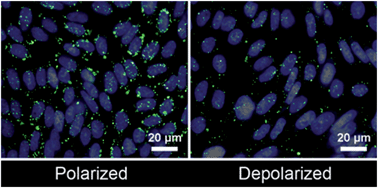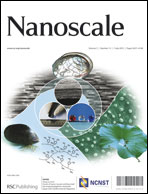Membrane potential mediates the cellular binding of nanoparticles†
Abstract
The use of nanoparticles for cellular therapeutic or sensing applications requires nanoparticles to bind, or adhere, to the cell surface. While nanoparticle parameters such as size, shape, charge, and composition are important factors in cellular binding, the cell itself must also be considered. All cells have an electrical potential across the plasma membrane driven by an ion gradient. Under standard conditions the ion gradient will result in a −10 to −100 mV potential across the membrane with a net negative charge on the cytosolic face. Using a combination of flow cytometry and fluorescence microscopy experiments and dissipative particle dynamics simulations, we have found that a decrease in membrane potential leads to decreased cellular binding of anionic nanoparticles. The decreased cellular binding of anionic nanoparticles is a general phenomenon, independent of depolarization method, nanoparticle composition, and cell type. Increased membrane potential reverses this trend resulting in increased binding of anionic nanoparticles. The cellular binding of cationic nanoparticles is minimally affected by membrane potential due to the interaction of cationic nanoparticles with cell surface proteins. The influence of membrane potential on the cellular binding of nanoparticles is especially important when considering the use of nanoparticles in the treatment or detection of diseases, such as cancer, in which the membrane potential is decreased.


 Please wait while we load your content...
Please wait while we load your content...